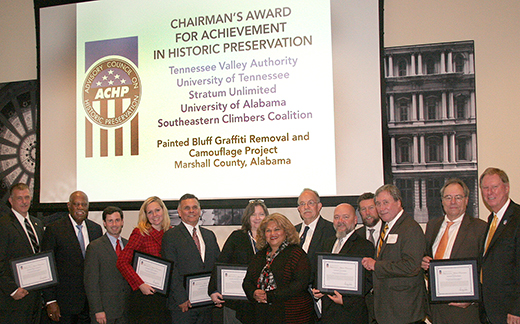Tribe honored for efforts to preserve historic Painted Bluff in homelands
CONTRIBUTED BY Dana Lance, Media Relations.
This article appeared in the January 2017 edition of the Chickasaw Times
A prehistoric site with images of fish, snakes, animals and human figures dating back more than 600 years is being preserved for future generations thanks to a collaborative effort involving the Chickasaw Nation. Located along the Tennessee River in Alabama, Painted Bluff is a landmark rock outcropping along the Tennessee River in Alabama. The bluff has dozens of prehistoric paintings and petroglyphs (prehistoric rock carvings), as well as historic signatures. The bluff is considered one of the most important rock-art examples in the southeastern U.S. The site contains more than 100 petroglyphs, pictographs and historic signatures from the Mississippian period through the 1950s. Experts consider the Mississippian period to be 800 to 1600 A.D. More than 80 images of fish, snakes, animals and human figures adorn the landmark in the Southeastern homelands.
“The (prehistoric) designs are out of the Mississippian period,” Chickasaw Nation director of Research and Cultural Interpretation LaDonna Brown said. “There are all these different paintings and some of them are figures that look as if they are engaged in ceremonial or ritual activity,” she said. “There are other places where there are drawings of catfish.” Time, weather, vandalism and rock climbing havew taken their toll on the ancient art. In 2013, the Alabama Historical Commission named Painted Bluff to its “Places in Peril” list. The list highlights the most significant endangered landmarks in the state. The Tennessee Valley Authority (TVA), which owns the property, consulted with 15 federally-recognized tribes, including the Chickasaw Nation, regarding restoration of the ancient paintings. “Our Heritage Preservation office met with the TVA and discussed how we could provide help with this project,” Ms. Brown said. “The one thing the TVA realized it needed was cultural information about these petroglyphs and to better understand the tribal perspective,” Ms. Brown said.
In a joint effort to preserve, protect and record the ancient drawings for publication in the future, Ms. Brown visited the site west of Huntsville last summer. “I had so much fun just being on the river and imagining, ‘this was a river my ancestors saw every day and probably came down and fished and saw the eagles and hawks flying near the river and ducks in the water’,” she said. “It just took me back to an early time, this prehistoric time of these types of petroglyphs.” A petroglyph specialist who worked on the project analyzed the ancient drawings with radio carbon dating. The art was confirmed to be Mississippian period. Other graffiti on the rock formation includes soldiers’ names from the Civil War period and markings from the early 1900s. “That is definitely historic and also needs to be protected,” Ms. Brown said. Once it was decided to preserve the graffiti more than 50 years old, a bevy of volunteers removed or camouflaged any date or names added since 1966.
A volunteer archeologist from Tuscaloosa, Ala., who is a former tattoo artist, led the camouflage effort using water and weather proof paint. “Now it looks just like part of the stone,” Ms. Brown said. The Chickasaw Nation will submit a written tribal perspective about the petroglyphs. The report will be combined with the archeologist’s perspective for a curriculum, which will be taught to elementary students in Alabama schools. “Painted Bluff is a very culturally-rich area,” Ms. Brown said. “Our ancestors took the time to stop and create the art work on the side of this bluff. Because of that action, this place is a special place. It is more than just drawings on the side of a wall.”
Advisory Council on Historic Preservation Award The Advisory Council on Historic Preservation (ACHP) awarded the Chickasaw Nation, along with 14 other federally-recognized tribes, federal and state agencies and other stakeholders the ACHP’s Chairman’s Award for Achievement in Historic Preservation. The award was presented Nov. 29 in Washington, D.C. Other tribes participating in the project included the Cherokee Nation, Eastern Band of Cherokee Indians, United Keetoowah Band of Cherokee Indians in Oklahoma, Muscogee (Creek) Nation of Oklahoma, Alabama-Coushatta Tribe of Texas, Alabama-Quassarte Tribal Town, Kialegee Tribal Town, Thlopthlocco Tribal Town, Poarch Band of Creek Indians, Seminole Nation of Oklahoma, Seminole Tribe of Florida, Absentee Shawnee Tribe of Oklahoma, Eastern Shawnee Tribe of Oklahoma and Shawnee Tribe of Oklahoma. Other preservation project partners included the University of Alabama’s Office of Archaeological Research, the University of Tennessee, Tennessee Valley Authority, Alabama Historical Commission, Stratum Unlimited and the Southeastern Climbing Coalition.